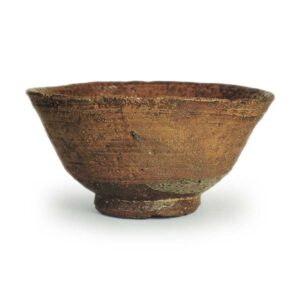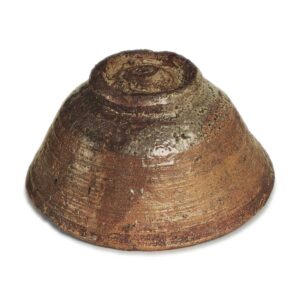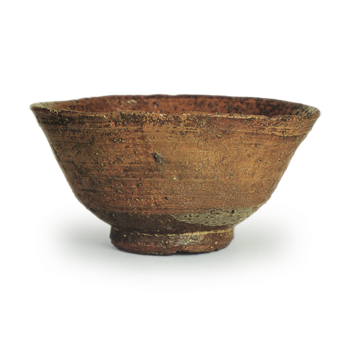

Held in the Hatakeyama Memorial Museum
Height: 7.9-8.0cm
Diameter: 14.6-15.3cm
Outer diameter of foot ring: 6.6cm
Height of foot ring: 1.2cm
Like the Chigusa, Ikesui, Natsuyama, Wakakusa and Yakikae, the body of this piece is divided into two parts, one covered in white glaze and the other in yellow-brown glaze, and the inside has a white brush pattern. This type of irabo is called ko-irabo, and is the type most prized by tea masters.
The year before the end of the war, Mr. Ken Nomori discovered shards of this type of pottery at the site of a kiln in Changgye, Gyeongsangnam-do, and it is thought that they were made at the Changgye kiln.
Iroha is a type of Korean earthenware that was made to resemble tea bowls, not by tea masters, but by Japanese tea masters, and of the various types of Iroha, this type is the most complex in terms of technique. The glaze and foot ring are particularly traditional, and tea masters prize this type of irabo in particular. The clay is coarse, with a high iron content, and the body is covered with a translucent white glaze on one side and a thin, amber-colored glaze on the other. It seems that the white glaze was applied after the brown glaze, and the white glaze covers the entire surface of the brown glaze on the underside of the foot ring. The glaze has not fully melted due to the incomplete firing.
The firing is slightly oxidized, and the overall color is a dark loquat color, but if you look closely, you can see that one side has a thin, light brown glaze, and the other side has a light yellowish-brown color due to the iron content of the clay.
The waist is covered in a thick layer of glaze, with a combination of translucent white glaze and a thick layer of candy-colored glaze, giving it a dignified, well-made appearance.
The construction is thick for an irabo, and the foot ring, which is made to look like a bamboo joint, is particularly solid. The rim is pulled tight, so it is beveled, and a large-sized hood is standing up on the underside. This type of irabo, which is commonly referred to as Chigusa, Ikesui, Natsuyama, etc., and is also called Chigusa, Ko-irabo, or Katamigawari, is the same in terms of appearance, workmanship, technique, glaze, and especially the construction of the foot ring and the tone of the white brushwork on the inside, and it is thought that it was probably made by the same person.
The inside is also glazed with a mixture of candy-colored glaze and white glaze, but there is a quick brush of white clay under the white glaze, which is a characteristic feature of this type of Iroha ware.
The accompanying items that came from the Mitsui family in the south are made of paulownia wood with a white finish. There is a note on the front of the lid that says “Yunraho tea bowl”, and the outer box is made of paulownia wood with a white finish and a lacquer coating. The paper on the front of the lid says “Old Ra-ho”, but the author is not sure of the details.



